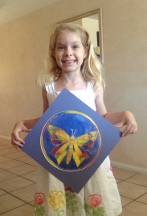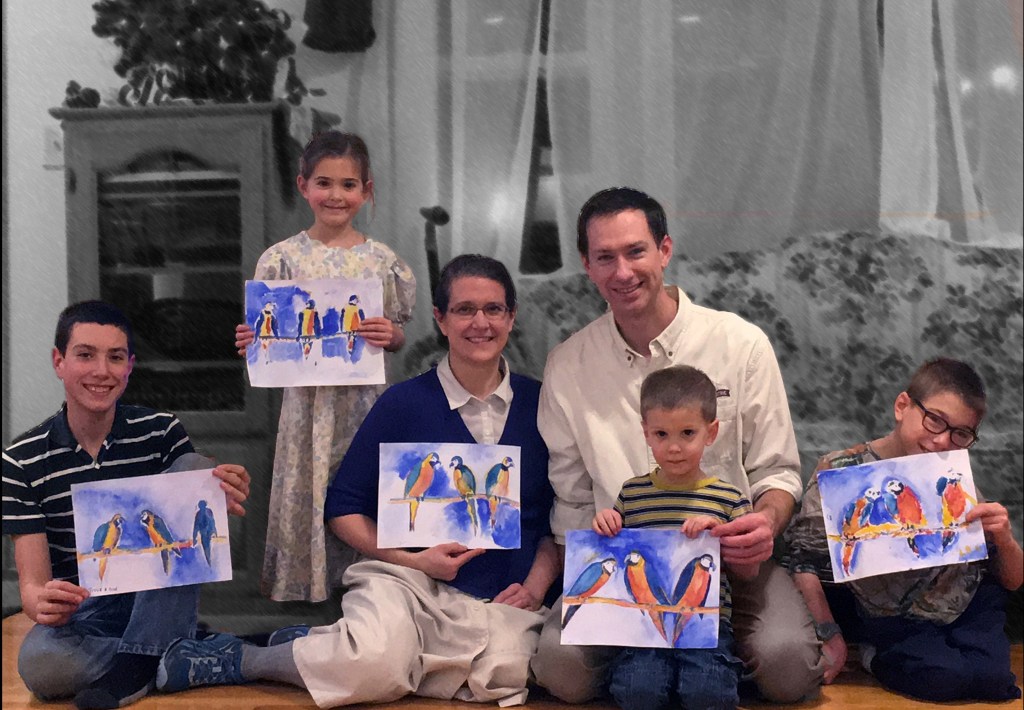Creating a Masterpiece caught my eye when they had an exhibit space across the aisle from mine at a homeschool conference. They had set up easels and workspace for children to actually complete a “Baby Bluebird” art project with pastels without any parental assistance. Children who appeared to be as young as about six and seven watched the lesson, following the step-by-step instructions. Every one of them created a beautiful finished artwork within an hour. I didn’t see any of the children getting frustrated or having significant difficulties with the project, even though I suspect most of them had never worked with pastels before.
The project was so successful I thought I’d try it with my six-year-old granddaughter. When we started the lesson at home, I discovered that the actual lesson was actually spread out a bit more, broken into a few sessions to keep children from feeling pressured to do too much in one sitting. My granddaughter, like the children at the conference, didn’t want to stop at the end of the first session but wanted to keep on going until she was finished. She was so pleased with her project that she thought she’d done even better than the instructor!
The artist and creative genius behind Creating a Masterpiece, Sharon Hofer, offers art classes to children of all ages. In those classes, children learn to work with many different art media: colored pencils, acrylic paints, oil pastels, sculpting, ink, silk paint, charcoal, copper tooling, watercolors, and more. Based on her experience with her live classes, Hofer has created online video lessons that take children through the creation of many different art projects. Each project is broken down into a number of sessions that depends upon the complexity of the work.
Creating a Masterpiece projects are listed under five or six levels of increasing difficulty (six levels for projects involving many different media and five levels for drawing). Hofer doesn’t suggest ages for the various levels since children vary greatly in their artistic ability and preference for different art media as well as their attention span and patience.
There are four different monthly subscription options: Art Essentials, Drawing, Art History, and Full Access (to all programs). Each program includes access to all levels. Art Essentials has more than 80 projects presented in 200+ lessons, and it introduces more than 28 different art media. The Drawing Program has 60 projects presented in 80+ lessons and teaches students how to work with drawing pencils, colored pencils, and charcoal. Art History has 35 projects presented in 90+ lessons. Art History students are introduced to an even broader range of art media as they learn skills such as faux metal work, faux stained glass, glass etching, glass mosaic, and printmaking, in addition to work with oil paints, ink, pencils, charcoal, sculpture, acrylic paints, and colored markers. The Full Access subscription includes all of the lessons in these three subscriptions.
Creating a Masterpiece projects are divided into levels to make it easier to identify the correct starting place for each child. Art Essentials has six levels, while the Drawing Program has eight. Art History divides projects into three themed levels. In the first level, students recreate famous art styles from the past. Projects in the second level are based on historical themes, and in the third level, students try to recreate a historical masterpiece. Hofer doesn’t suggest ages for the various levels since children vary greatly in their artistic ability and preference for different art media as well as their attention span and patience.
Children of all ages should probably begin with first-level projects since none of these are babyish or too young, even for teens and adults. Children of varying ages and abilities can easily work on the same projects at the same time, so Creating a Masterpiece projects are great for both families and co-op groups.
In her video lessons, Hofer demonstrates and explains each step of the project. She has a very warm, friendly manner that encourages children. She covers just about everything that might come up, knowing from her experience with so many children where they are likely to encounter problems. You can watch a sample video on Hofer’s website to get an idea of how the lessons are presented. Note that Hofer occasionally relates art to the beauty of God’s creation, reflecting a Christian worldview.
Art materials are not included. Hofer recommends that students work with high-quality media. This produces better results and students get a taste of the true potential of each art medium. For example, high-quality pastels are generally much easier to rub to produce a smooth color than cheap pastels that can leave “crayon-like” lines. To help you obtain the correct art materials and tools for each project, Creating a Masterpiece has lists of the resources needed for each project and links to BlickU, where materials for each supply list are already gathered in carts for you at reasonable prices. (You can always purchase products elsewhere if you choose.)
Hofer and her staff are glad to answer by email any questions that might arise as students work on projects. She also encourages children to send in digital pictures of their projects.
With the Creating a Masterpiece series, Hofer’s carefully designed lessons and your use of quality art media will almost certainly result in finished projects that are worthy of mounting or framing for display.
More about My Personal Experience: Rainbow Butterfly

Hofer encourages children to make their own choices although she demonstrates a particular way to do each project. My granddaughter followed Hofer’s example for the most part, but as she gained confidence, she started experimenting with her own color choices.
The silk painting was the kind of project even adults would enjoy—not something you would normally expect a six-year-old to be able to tackle. Yet, Hofer’s careful instruction made it a success.
Through the butterfly project, my granddaughter gained a tremendous understanding of color theory since Hofer has students begin with only red, yellow, and blue paint, then mix to create a pallet of six colors. In addition, students learn how colors blend beyond our initial palette creation since the paint colors readily “bleed” into one another on the silk within each section within a resist boundary. This is just one example of the depth of learning that takes place with projects of this complexity. While most of Hofer’s projects involve drawing skills, other elements of each project expand the student’s understanding of art principles as well as techniques with various media.








